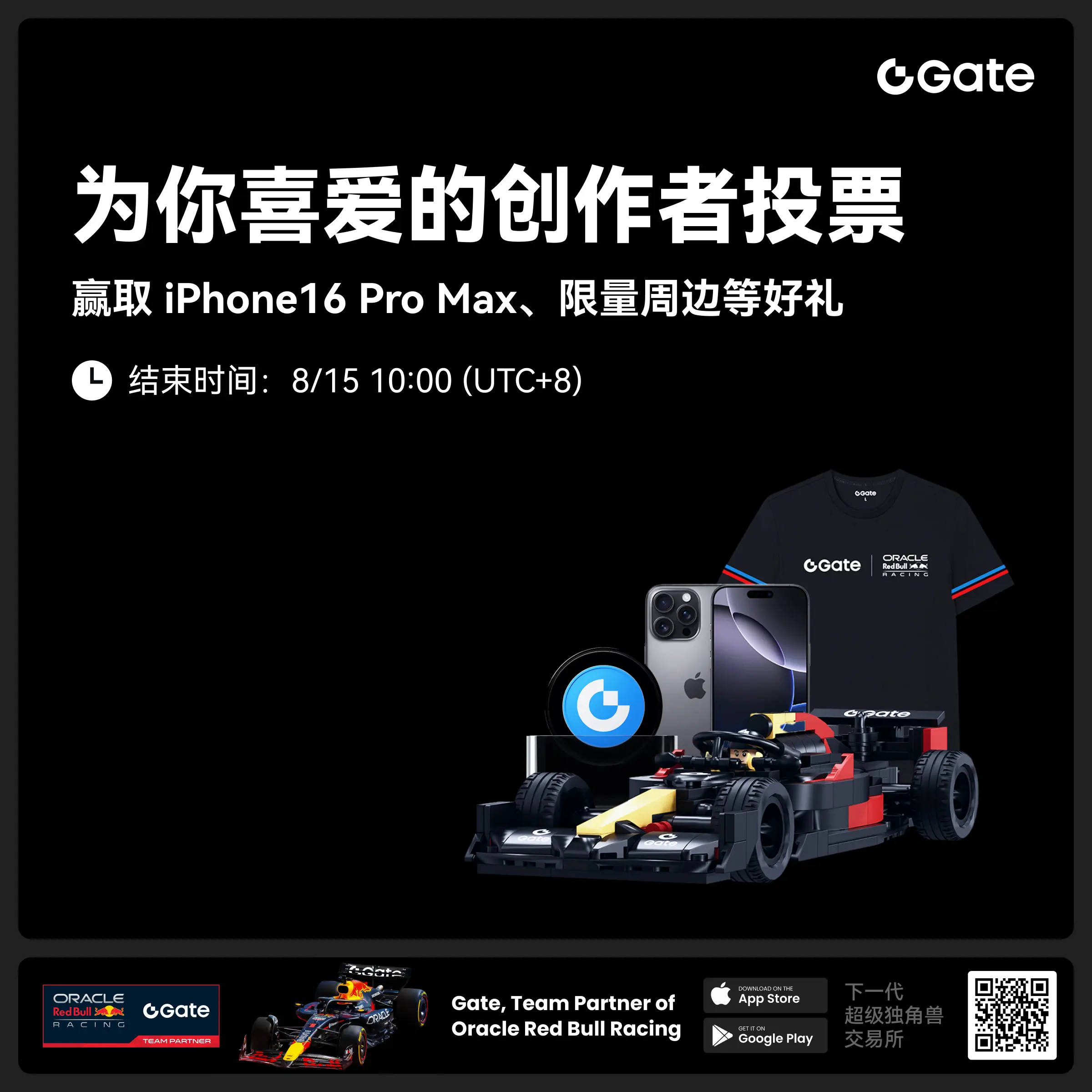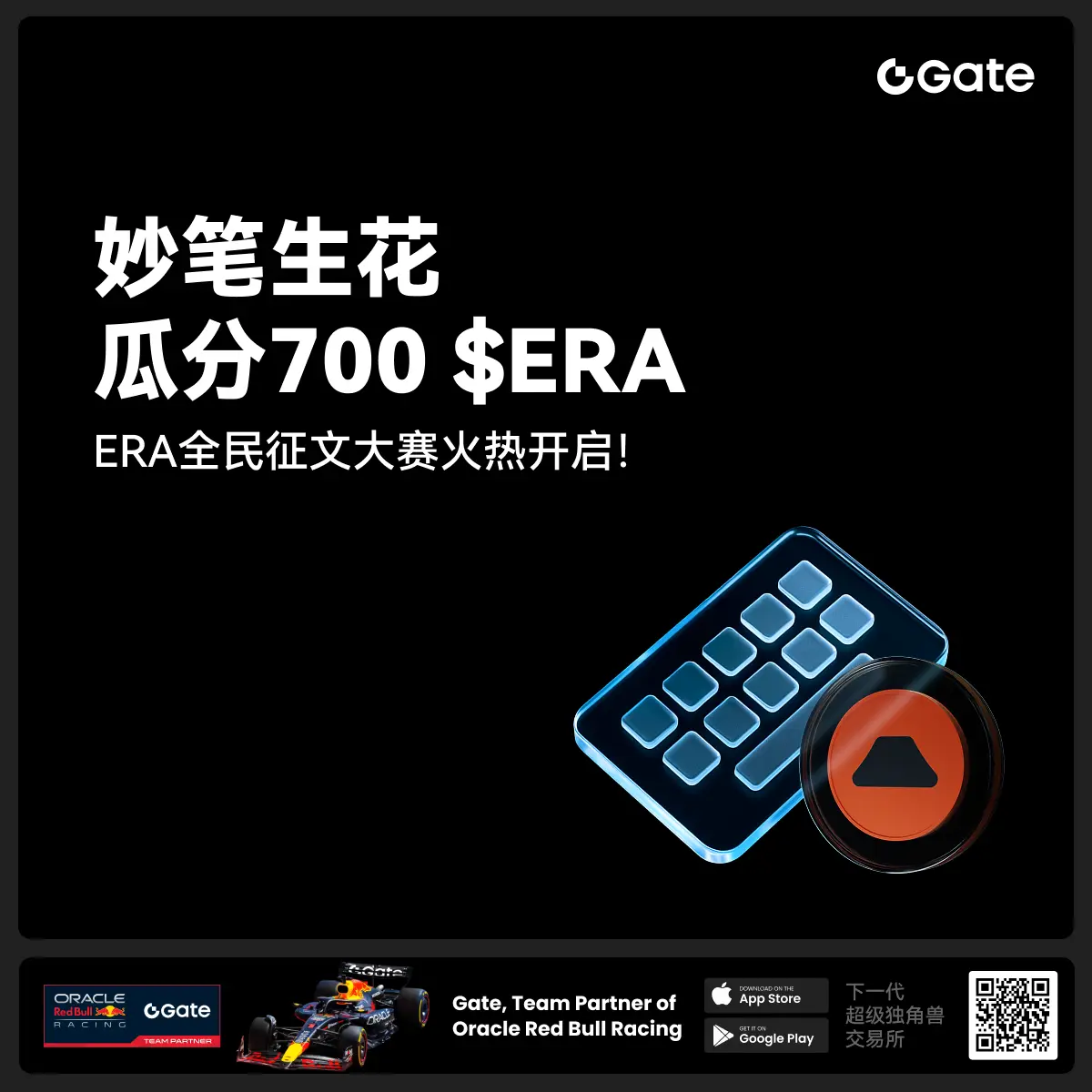更多
- 話題1/3
28k 熱度
12k 熱度
24k 熱度
30k 熱度
17k 熱度
- 置頂
- 🎉Gate 2025 上半年社區盛典:內容達人評選投票火熱進行中 🎉
🏆 誰將成爲前十位 #Gate广场# 內容達人?
投票現已開啓,選出你的心頭好
🎁贏取 iPhone 16 Pro Max、限量週邊等好禮!
📅投票截止:8 月 15 日 10:00(UTC+8)
立即投票: https://www.gate.com/activities/community-vote
活動詳情: https://www.gate.com/announcements/article/45974
- 📢 #Gate广场征文活动第二期# 正式啓動!
分享你對 $ERA 項目的獨特觀點,推廣ERA上線活動, 700 $ERA 等你來贏!
💰 獎勵:
一等獎(1名): 100枚 $ERA
二等獎(5名): 每人 60 枚 $ERA
三等獎(10名): 每人 30 枚 $ERA
👉 參與方式:
1.在 Gate廣場發布你對 ERA 項目的獨到見解貼文
2.在貼文中添加標籤: #Gate广场征文活动第二期# ,貼文字數不低於300字
3.將你的文章或觀點同步到X,加上標籤:Gate Square 和 ERA
4.徵文內容涵蓋但不限於以下創作方向:
ERA 項目亮點:作爲區塊鏈基礎設施公司,ERA 擁有哪些核心優勢?
ERA 代幣經濟模型:如何保障代幣的長期價值及生態可持續發展?
參與並推廣 Gate x Caldera (ERA) 生態周活動。點擊查看活動詳情:https://www.gate.com/announcements/article/46169。
歡迎圍繞上述主題,或從其他獨特視角提出您的見解與建議。
⚠️ 活動要求:
原創內容,至少 300 字, 重復或抄襲內容將被淘汰。
不得使用 #Gate广场征文活动第二期# 和 #ERA# 以外的任何標籤。
每篇文章必須獲得 至少3個互動,否則無法獲得獎勵
鼓勵圖文並茂、深度分析,觀點獨到。
⏰ 活動時間:2025年7月20日 17
- 📢 ETH衝擊4800?我有話說!快來“Gate廣場”秀操作,0.1 ETH大獎等你拿!
牛市預言家,可能下一個就是你!想讓你的觀點成爲廣場熱搜、贏下ETH大獎?現在就是機會!
💰️ 廣場5位優質發帖用戶+X瀏覽量前5發帖用戶,瓜分0.1 ETH!
🎮 活動怎麼玩,0門檻瓜分ETH!
1.話題不服來辯!
帶 #ETH冲击4800# 和 #ETH# 在 廣場 或 K線ETH下 圍繞一下主題展開討論:
-ETH是否有望突破4800?
-你看好ETH的原因是什麼?
-你的ETH持倉策略是?
-ETH能否引領下一輪牛市?
2. X平台同步嗨
在X平台發帖討論,記得帶 #GateSquare# 和 #ETH冲击4800# 標籤!
把你X返連結提交以下表單以瓜分大獎:https://www.gate.com/questionnaire/6896
✨發帖要求:
-內容須原創,字數不少於100字,且帶活動指定標籤
-配圖、行情截圖、分析看法加分,圖文並茂更易精選
-禁止AI寫手和灌水刷屏,一旦發現取消獎勵資格
-觀點鮮明、邏輯清晰,越有料越好!
關注ETH風向,創造觀點價值,從廣場發帖開始!下一個牛市“預言家”,可能就是你!🦾🏆
⏰ 活動時間:2025年7月18日 16:00 - 2025年7月28日 23:59(UTC+8)
【立即發帖】 展現你的真知灼見,贏取屬於你的ETH大獎!
- 🎉【Gate 3000萬紀念】曬出我的Gate時刻,解鎖限量好禮!
Gate用戶突破3000萬!這不僅是數字,更是我們共同的故事。
還記得第一次開通帳號的激動,搶購成功的喜悅,或陪伴你的Gate週邊嗎?
📸 參與 #我的Gate时刻# ,在Gate廣場曬出你的故事,一起見證下一個3000萬!
✅ 參與方式:
1️⃣ 帶話題 #我的Gate时刻# ,發布包含Gate元素的照片或視頻
2️⃣ 搭配你的Gate故事、祝福或感言更佳
3️⃣ 分享至Twitter(X)可參與瀏覽量前10額外獎勵
推特回鏈請填表單:https://www.gate.com/questionnaire/6872
🎁 獨家獎勵:
🏆 創意大獎(3名):Gate × F1紅牛聯名賽車模型一輛
👕 共創紀念獎(10名): 國際米蘭同款球員衛衣
🥇 參與獎(50名):Gate 品牌抱枕
📣 分享獎(10名):Twitter前10瀏覽量,送Gate × 國米小夜燈!
*海外用戶紅牛聯名賽車折合爲 $200 合約體驗券,國米同款球衣折合爲 $50 合約體驗券,國米小夜燈折合爲 $30 合約體驗券,品牌抱枕折合爲 $20 合約體驗券發放
🧠 創意提示:不限元素內容風格,曬圖帶有如Gate logo、Gate色彩、週邊產品、GT圖案、活動紀念品、活動現場圖等均可參與!
活動截止於7月25日 24:00 UTC+8
3
微軟前員工下場做「ICM 概念」,Collaterize 爲何在 5 月暴漲 10 倍?
撰文:BUBBLE
「Internet Capital Markets」這個在 Solana 基金會主席 Lily Liu 布道的概念在 Believe 爆火之後在 Solana 上變得火熱,而另一個「ICM」概念的 RWA 項目 Collaterize 代幣 COLLAT 市值突破在近日突破 9000 萬美元,現回調至 5400 萬美元,自一月份發射以來於 900 萬美元市值左右持續盤整,終於在 5 月 18 日 爆發,Solana 聯創之一 Toly 轉發了 Collaterize 的 App Demo 視頻讓代幣暴漲,也讓市場重新關注起了這兩個微軟前員工的 RWA 項目。
ICM 是什麼?
幾年前,Solana 曾提出構建「鏈上納斯達克」的願景,但隨着納斯達克自身探索上鏈,敘事重心也逐漸轉向更具加密原生性的「互聯網資本市場(ICM)」。ICM 作爲傳統資本市場(TCM)的替代方案,使創業者能繞過風投和 IPO,通過代幣化直接向網路社區融資。以 Believe App 爲代表的 Solana 項目,實現了在 X 上輕鬆完成項目發行與投資。
如今「ICM」已取代「鏈上納斯達克」,成爲 Solana 的核心敘事。Solana 基金會主席 Lily Liu 多次強調,ICM 的目標是打造全球金融基礎設施,讓 55 億互聯網用戶都能無門檻參與資本市場。Solana 團隊也正全力將其構建爲鏈上 ICM 的關鍵基礎設施。
2024 年 12 月底,Solana 生態 Superteam 負責人 Akshay BD 曾在 Solana 2025 營銷備忘錄中提到「互聯網資本市場」和「F.A.T. 協議工程」兩個概念。他認爲在 2024 年,企業將直接「在互聯網」上市,並能接觸到超過十億名持有私鑰的投資者——他們用手中的資金爲自己期望的未來投票,不僅限於股票,而是涵蓋所有值得擁有的資產類別、文化與理念。
而數據表明,從 2005 年僅不到 8000 家私募股權公司需要從某個地方獲取流動性,到 2024 年已經暴漲至 3 萬家的需求了,似乎「在互聯網上市」變得迫在眉睫。
盡管依舊存在諸多批評,比如缺乏監管、項目門檻過低、容易發布誤導性 token 等問題,ICM 仍具有強勁的大衆採用潛力,尤其在通過簡潔的用戶體驗、法幣支付入口及病毒式敘事推廣 Web3 給 Web2 用戶方面。爲了實現長期發展,像 Believe 這樣的平台需要跳出短期炒作,推動創始人問責機制、優化 token 經濟模型、構建 DAO 治理,並實現真實效用,從而將 ICM 從一場 Meme 熱潮,真正轉變爲新的資本形成範式。在經歷了 Pumpfun、Timefun、Believe 等一系列產品的更新,市場目前更需要一個更開放的、無需許可的融資和交易生態,覆蓋從 meme 幣到 NFT 再到初創項目的各種資產,而 Collaterize 便是在這個概念中將 ICM 的業務延展至 RWA。
RWA 也有自己的 Bonding Curve——Collaterize
Collaterize 的創始人是兩個都曾任職於微軟的法國人 Paul Antoine Arrighi 和 Pierre Hoffman,Paul 曾在 2015 年開啓過一次自己的創業項目 OneClight,主要功能是類似於 Onkey,在網頁中可以無需「輸入密碼」這一動作通行。而在一年後該項目並未有太大的進展,於是在 2017 年 Paul 前往在微軟開啓自己的另一段長達 4 年的職業生涯。
而另一個創始人 Pierre 也在同年加入微軟,負責管理微軟合作夥伴,確保軟件資產管理服務在公共和私營部門的準確部署。而僅僅工作了一年後便離開微軟,Pierre 離開之後加入 IOTA 基金會負責業務拓展。
Paul Antoine Arrighi 在 AWS Demo Day 展示 Collaterize 的 App
Pierre Hoffman 曾表示「RWA 能夠實現一些以前不可能實現的功能,例如流動性、可編程性或更廣泛的訪問權限,因此是有意義的。我們開始看到這方面的早期案例,尤其是在美國國債或股票等公開交易的 RWA 上,但私人資產中存在更大的機會,因爲這些資產目前無法進入流動性較強的市場」
美國、香港、以及 Collaterize 項目方所在的法國的 RWA 領域發展情況
Hoffman 進一步說「如果我們能夠將這些資產上鏈,在適當的框架下,並保持透明度。我們就可以讓市場決定哪些資產具有足夠的價值,可以進行交易、抵押和使用。現在感覺還爲時過早,但基本面正在逐步顯現」,這話與白宮加密事務負責人 David Sacks 曾提過的「萬物上鏈」概念不謀而合,而從他們文檔中支持的資產類型也在某種程度上展現了 Collaterize 的野心。
Collaterize 支持將任何 RWA 代幣化的功能,從棒球卡到房地產,從公司股權到代幣。比較特別的該協議採用動態債券曲線,一旦達到目標,資產便可在 Meteora 上交易,當前 Meteora 已審核該債券曲線方案。基於 Solana 的協議對交易收取 1% 的費用,遷移到 Meteora 時收取 5% 的費用。另外 15% 的費用將進入 Meteora 流動資金池。
當然創建代幣的流程則不如 Believe 或者 Pumpfun 的 Bonding Curve 模式這般容易,在代幣上線時會經歷 Collaterize 相對嚴格的審查。首先申請者需要持有 100000 枚 $COLLAT 然後投遞申請,Collaterize 會審批公司是否具備多個緯度的可持續性,包括具備清晰的商業模式與增長計劃,能夠創造穩定收入並拓展新市場;擁有良好的盈利記錄和可預測的現金流等。此外,特定高價值收藏品和奢侈品可被考慮爲資產,前提是具備權威評估、明確出處及保險存儲等保障。
根據公開的信息可以得知,當下 Collaterize 合作的最高價值的產品是即將發行的位於法國的房產「Token」,這次合作是 Collaterize 與 ARP(Asset Realty Partners)合作後首次推出的產品,ARP 在 2025 年 3 月的 MIPIM「國際房地產展」上宣布與 Collaterize 合作。
這家成立於 2006 年的房地產綜合服務公司來頭也不小,總部位於法國巴黎,由 Pascal Roth 創立。他在德國抵押銀行工作近 20 年後,創建了 ARP 以提供專業的房地產服務,該集團當前管理數十億歐元的資產。
而這並不是他們第一次嘗試「碎片化房地產資產」,其在 2020 年通過控股子公司 Beefordeal 進入房地產眾籌市場,該平台允許投資者以最低 1000 歐元的資金參與房地產項目,提供約 10% 的潛在回報,截至 2023 年,平台已經累計融資超過 1100 萬歐元。
不過即使在現實世界的合作陣容如此豪華,Collaterize 還是逃不過一個悖論。當前階段,Crypto Native 用戶會本能性的拒絕審查機制導致他們排斥合規化的資產協議,而傳統資產用戶對 Crypto 的接口和資產形式並不接受,從而形成了這樣「合規與用戶需求雙錯位」的市場悖論。
根據 Collaterize 的鏈上信息,在項目成立的四個月後該區塊鏈的活躍度依然十分低,直到今日總交易 tx 才僅僅 7 萬次,而總地址數也僅僅 381 個,如果僅對比這一數值,甚至不如一個數十萬市值的 Meme coin 的持有人數。但無論如何,RWA 還存在一個相當漫長的發展期,背後 75 萬億美元的市場潛力雖然無限,但不管是法規、基礎設施還是審查都存在十分大的不確定性。
但新的時代一直都需要新的探索者,Collaterize 作爲其中的一員也同樣在這片無垠的海洋中尋找「可能」存在的寶藏。